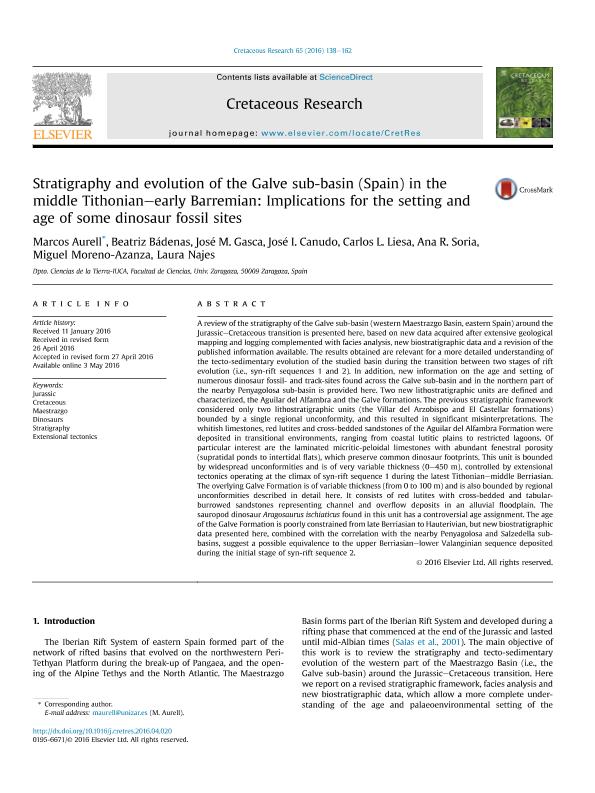Mostrar el registro sencillo del ítem
dc.contributor.author
Aurell, Marcos
dc.contributor.author
Bádenas, Beatriz
dc.contributor.author
Gasca Pérez, José Manuel

dc.contributor.author
Canudo, José I.
dc.contributor.author
Liesa, Carlos L.
dc.contributor.author
Soria, Ana R.
dc.contributor.author
Moreno Azanza, Miguel

dc.contributor.author
Najes, Laura
dc.date.available
2018-10-08T18:09:52Z
dc.date.issued
2016-10
dc.identifier.citation
Aurell, Marcos; Bádenas, Beatriz; Gasca Pérez, José Manuel; Canudo, José I.; Liesa, Carlos L.; et al.; Stratigraphy and evolution of the Galve sub-basin (Spain) in the middle Tithonian-early Barremian: Implications for the setting and age of some dinosaur fossil sites; Academic Press Ltd - Elsevier Science Ltd; Cretaceous Research; 65; 10-2016; 138-162
dc.identifier.issn
0195-6671
dc.identifier.uri
http://hdl.handle.net/11336/61871
dc.description.abstract
A review of the stratigraphy of the Galve sub-basin (western Maestrazgo Basin, eastern Spain) around the Jurassic-Cretaceous transition is presented here, based on new data acquired after extensive geological mapping and logging complemented with facies analysis, new biostratigraphic data and a revision of the published information available. The results obtained are relevant for a more detailed understanding of the tecto-sedimentary evolution of the studied basin during the transition between two stages of rift evolution (i.e., syn-rift sequences 1 and 2). In addition, new information on the age and setting of numerous dinosaur fossil- and track-sites found across the Galve sub-basin and in the northern part of the nearby Penyagolosa sub-basin is provided here. Two new lithostratigraphic units are defined and characterized, the Aguilar del Alfambra and the Galve formations. The previous stratigraphic framework considered only two lithostratigraphic units (the Villar del Arzobispo and El Castellar formations) bounded by a single regional unconformity, and this resulted in significant misinterpretations. The whitish limestones, red lutites and cross-bedded sandstones of the Aguilar del Alfambra Formation were deposited in transitional environments, ranging from coastal lutitic plains to restricted lagoons. Of particular interest are the laminated micritic-peloidal limestones with abundant fenestral porosity (supratidal ponds to intertidal flats), which preserve common dinosaur footprints. This unit is bounded by widespread unconformities and is of very variable thickness (0-450 m), controlled by extensional tectonics operating at the climax of syn-rift sequence 1 during the latest Tithonian-middle Berriasian. The overlying Galve Formation is of variable thickness (from 0 to 100 m) and is also bounded by regional unconformities described in detail here. It consists of red lutites with cross-bedded and tabular-burrowed sandstones representing channel and overflow deposits in an alluvial floodplain. The sauropod dinosaur Aragosaurus ischiaticus found in this unit has a controversial age assignment. The age of the Galve Formation is poorly constrained from late Berriasian to Hauterivian, but new biostratigraphic data presented here, combined with the correlation with the nearby Penyagolosa and Salzedella sub-basins, suggest a possible equivalence to the upper Berriasian-lower Valanginian sequence deposited during the initial stage of syn-rift sequence 2.
dc.format
application/pdf
dc.language.iso
eng
dc.publisher
Academic Press Ltd - Elsevier Science Ltd

dc.rights
info:eu-repo/semantics/openAccess
dc.rights.uri
https://creativecommons.org/licenses/by-nc-sa/2.5/ar/
dc.subject
Cretaceous
dc.subject
Dinosaurs
dc.subject
Extensional Tectonics
dc.subject
Jurassic
dc.subject
Maestrazgo
dc.subject
Stratigraphy
dc.subject.classification
Meteorología y Ciencias Atmosféricas

dc.subject.classification
Ciencias de la Tierra y relacionadas con el Medio Ambiente

dc.subject.classification
CIENCIAS NATURALES Y EXACTAS

dc.title
Stratigraphy and evolution of the Galve sub-basin (Spain) in the middle Tithonian-early Barremian: Implications for the setting and age of some dinosaur fossil sites
dc.type
info:eu-repo/semantics/article
dc.type
info:ar-repo/semantics/artículo
dc.type
info:eu-repo/semantics/publishedVersion
dc.date.updated
2018-10-04T16:21:14Z
dc.journal.volume
65
dc.journal.pagination
138-162
dc.journal.pais
Estados Unidos

dc.journal.ciudad
Amsterdam
dc.description.fil
Fil: Aurell, Marcos. Universidad de Zaragoza; España
dc.description.fil
Fil: Bádenas, Beatriz. Universidad de Zaragoza; España
dc.description.fil
Fil: Gasca Pérez, José Manuel. Consejo Nacional de Investigaciones Científicas y Técnicas; Argentina. Universidad de Zaragoza; España
dc.description.fil
Fil: Canudo, José I.. Universidad de Zaragoza; España
dc.description.fil
Fil: Liesa, Carlos L.. Universidad de Zaragoza; España
dc.description.fil
Fil: Soria, Ana R.. Universidad de Zaragoza; España
dc.description.fil
Fil: Moreno Azanza, Miguel. Universidad de Zaragoza; España
dc.description.fil
Fil: Najes, Laura. Universidad de Zaragoza; España
dc.journal.title
Cretaceous Research

dc.relation.alternativeid
info:eu-repo/semantics/altIdentifier/doi/https://dx.doi.org/10.1016/j.cretres.2016.04.020
dc.relation.alternativeid
info:eu-repo/semantics/altIdentifier/url/https://www.sciencedirect.com/science/article/pii/S0195667116300908
Archivos asociados
